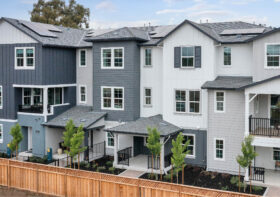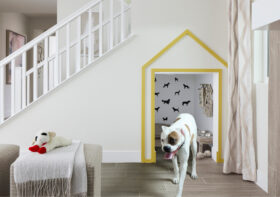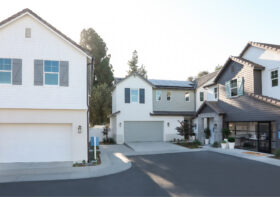How To Design a Community

Have you ever wondered how Planners create master planned communities? It takes knowledge of a city’s zoning regulations and codes, a library of building types, and the ability to play a life-sized version of Tetris with homes, parks, and roads.
Step 1: Research
Finding the city codes on development are the first initial steps to designing. Every city has slightly different requirements and it is essential to know what you CAN and CANNOT do before you start designing.
Here are the most important city codes:
Density Requirements: How many units per acre are allowed within each zoning district?
Setback Requirements: Minimum setbacks are required from the property line to the front, sides, porches, garage, and rear of the house. Additionally, a city may be required a second and third floor offset.
Floor Area Ratio (FAR): The FAR is the ratio of a building’s total floor area (building footprint) to the property size it is built on. This restricts the building size.
Height Limit: Maximum heights will limit what type of buildings can be used and how many floors it may contain.
Open Space: Two types of open space are required: private and public. Private refers to open space just for the occupants of a home (back yard or porch) while public is for the entire community (park).
Parking Requirements: A minimum number of parking spaces are required for residents and guests. Different cities vary in those requirements as well as parking stall dimensions.
Street Design: Every city has different standards on street width and character. Typical details will show road, sidewalk, and parkway width as well as corner turn radii.
Step 2: Picking Product Types
Choosing the product type for the project site requires a good building footprint library. Depending on what the client wants, a product must be chosen based off of building type, living square footage, and size.
Here are the main types of housing products that Planners use:
Single Family Detached (SFD): Conventional homes with front doors and garages facing onto the street.
Green Court: Rear alley loaded homes; the front doors face each other and onto a common green paseo.
Motor Court: A cluster of 4-8 homes arranged around a common stub street or “court.”
Alley Loaded: The front doors of these homes will face onto the street, but the garages will be located on the rear of the house off a private alley.

Townhome: Attached residential units where the home owner will own/occupy everything from the ground floor to the roof.
Stacked Flat: Stacked residential units where the home owner will own/occupy an entire/part of a floor level.
Apartment: Multi-family building where tenants rent a unit within the building.
Condo: Multi-family building where tenants own a unit within the building.
Mixed Use: Multi-family or single family units that are located above commercial space.
Step 3: Plotting
Program
Know the program the client wants for the site. Know if there is supposed to be a large central park, an intensive trail network, or if there is to be a mixture of product types and where each product is located.
Constraints
Every site is different and may offer difficult constraints. Wetlands and protected trees, like oaks, will usually have a setback that will need to be worked around. Other constraints on a site may include pipelines and utilities, fly over zones, and irregular parcel shapes like triangles. The city code can also prove to be a huge constraint. For example if required parking ratios are extremely high, it may be impossible to hit the client’s desired unit count or density while still being able to park the site.
Plotting
Now well acquainted with the city codes, the client’s wishes and site constraints, it is time to design the site. Knowing the building dimensions and street widths, simply offset lines until you have a basic framework of neighborhood blocks. Excess space, or a lack there of, will result in rotating streets and finding creative solutions in those awkward corners. For example, cul-de-sacs or stub streets can be used to reach the interior of overly large blocks. In many cases, if the land plan is not coming together, it might be that the building dimensions are not right for the site. Testing a few different products might help create a more fluid layout. There is never one right way to design the framework of a community. Create many different alternatives and get peer review to help decide the best layout. Like a puzzle, constant rearranging and spatial problem solving is needed.

When the blocks are created, go back in and subdivide them into parcels. When placing a home inside each parcel, corner lots should be given an extra five to ten feet of side yard to act as a buffer from the cars and pedestrians. Refer to the city code for exact setbacks. The corner lot homes should have their garage driveways on the interior of the lot making it easier for residents to turn the corner and into their home. Every pair of homes should have their garages next to each other so that utilities can easily be run up to the homes.

Every community should have at least two entrances for ingress and egress. Its nice to have at least one of those entrances be the main entry point into the community with enhancements such as a central median, entry monumentation, and a park anchor at the end of the road. If only one entrance into a community can be achieved, an emergency vehicle access (EVA) exit may be required. No street in a community can go further than 150 ft without ending in a cul-de-sac, hammer head turn, or EVA exit. A fire truck and trash vehicles must be able to go down streets without getting stuck at the end. In the case of fire, a fire truck hose must be able to reach all the way around the building so a home may not be further than 150 ft from the street.

Sprinkled throughout the community, resting nodes and pocket parks are a welcome relief. Creating a small park out of an irregular corner or extra space will give the residents room for tot-lots and dog runs. Other street enhancements like sidewalk bulb outs, knuckles, and enhanced paving will help give the community character.
Small elements like how parking is arranged and housing orientation can also add to the overall feel of a community. Head in or angled parking is generally used for higher density communities like townhomes or apartments. When designing a single family detached plan, it is better to use parallel spaces to lend a more relaxed street character. Front doors rather than garages or back yards give a more desirable street frontage. When driving into the community, it is more pleasant to see the front of homes than fences or back alleys. Since they are visible on two sides, homes with stronger architectural features (like wrap around porches or side elevation character) look better on corner lots.
Most importantly, remember that one day families will call this community HOME. Try to design a place where YOU would feel happy living, and hopefully others will as well.





Leave a Reply